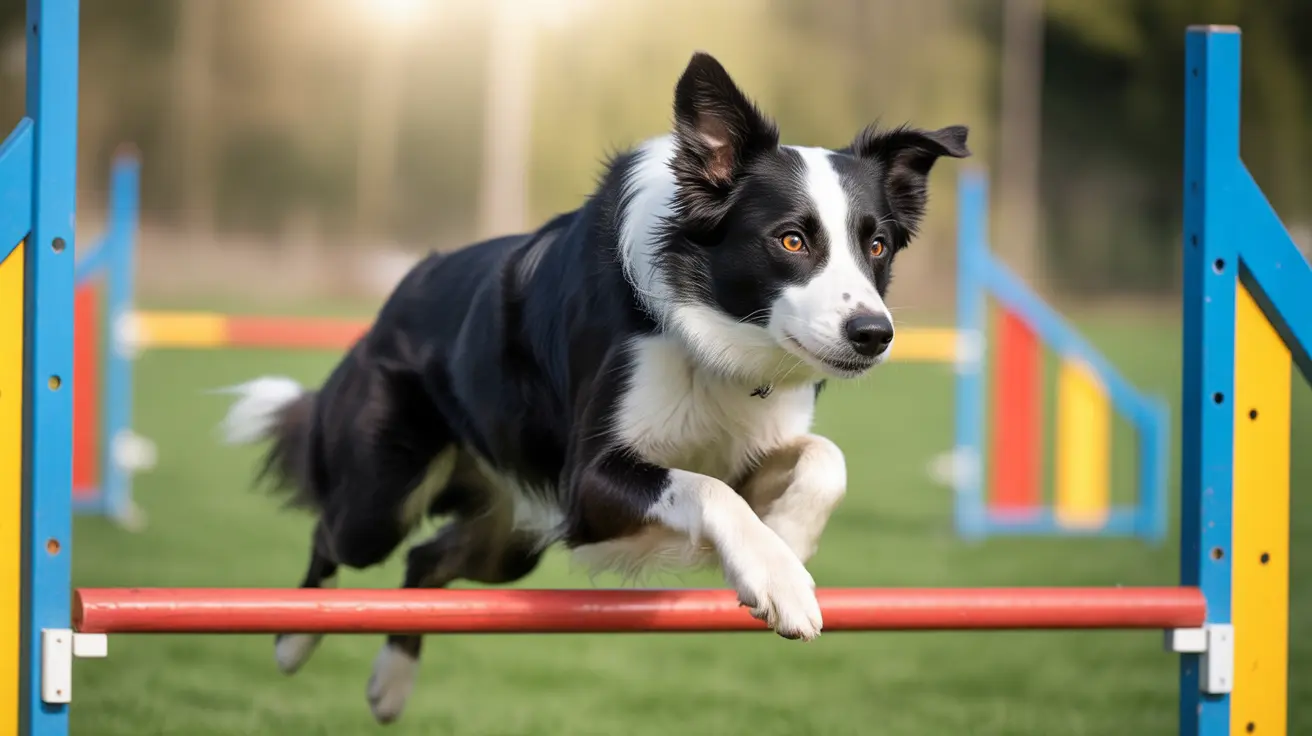The Complete Guide to Dog Sports and Activities for Dogs and Owners
Dog sports and activities for dogs and owners have evolved into an exciting world of competitive and recreational pursuits that strengthen the human-canine bond while promoting physical fitness and mental stimulation. These activities offer far more than simple exercise—they create opportunities for teamwork, skill development, and meaningful engagement that benefits both dogs and their handlers. Whether you're seeking a fun weekend activity or preparing for serious competition, the diverse landscape of canine sports provides options for every dog breed, age, and temperament.
From high-energy obstacle courses to precision scent work, dog sports cater to the natural abilities and instincts that make each breed unique. These activities tap into dogs' inherent drives—whether it's a Border Collie's herding instinct, a Retriever's desire to fetch, or a Hound's powerful scenting ability. By channeling these natural behaviors into structured activities, owners can provide their dogs with purposeful mental and physical challenges that reduce behavioral problems while enhancing obedience and socialization skills.
This comprehensive guide explores the most popular dog sports and activities available today, helping you discover the perfect match for your canine companion's abilities and your lifestyle. From beginner-friendly options to advanced competitive pursuits, we'll cover everything you need to know about getting started, staying safe, and maximizing the benefits of participating in dog sports with your four-legged teammate.
High-Energy Competitive Dog Sports
Dog Agility: The Ultimate Teamwork Challenge
Dog agility stands as one of the most popular and accessible dog sports, requiring dogs to navigate obstacle courses featuring jumps, tunnels, and weave poles under their handler's guidance. This dynamic sport emphasizes teamwork between dog and owner, as handlers must direct their dogs through complex courses using only voice commands and body language—no treats or toys are allowed during competition runs.
The beauty of agility lies in its ability to enhance coordination, obedience, and physical fitness simultaneously. Dogs develop improved balance and body awareness while learning to respond quickly to directional cues. For handlers, agility provides an excellent cardiovascular workout and teaches precise timing and communication skills. The sport accommodates dogs of various sizes through different jump height divisions, making it inclusive for breeds ranging from Chihuahuas to Great Danes.
Flyball: Fast-Paced Relay Racing
Flyball represents the epitome of team-based canine competition, featuring fast-paced relay races where teams of dogs jump hurdles to trigger a box that releases a tennis ball. Each dog must retrieve the ball and return to their handler before the next team member begins their run. This high-energy sport promotes stamina, discipline, and socialization as dogs learn to work alongside other canines in a structured environment.
The sport's appeal lies in its combination of speed, precision, and teamwork. Dogs must master hurdle jumping, ball catching, and quick turns while maintaining focus despite the excitement of competing alongside other dogs. Flyball teams often develop strong bonds, with both dogs and handlers forming lasting friendships through regular training sessions and competitions.
Scent-Based and Mental Stimulation Sports
Scentwork and Nose Work: Tapping Into Natural Abilities
Scentwork, also known as Nose Work, harnesses dogs' incredible olfactory abilities by teaching them to locate specific scents hidden in various environments. This mental exercise builds confidence and provides an outlet for natural scenting abilities that might otherwise go unused in domestic settings. Dogs learn to search vehicles, containers, interiors, and exterior areas to find target odors, ranging from essential oils in beginner classes to narcotics or explosives in advanced training.
The beauty of scent work lies in its accessibility—virtually any dog can participate regardless of age, size, or physical limitations. Senior dogs or those with mobility issues can excel in this sport since it relies primarily on mental engagement rather than physical agility. The activity also provides excellent mental stimulation that can tire dogs more effectively than purely physical exercise.
Mantrailing: Following Human Scent
Mantrailing takes scent work to the next level by teaching dogs to follow and track human scent trails to find specific individuals. Unlike traditional tracking that follows ground disturbance, mantrailing focuses on airborne human scent, making it a dog-led, non-competitive activity that builds confidence and harnesses dogs' natural tracking abilities. This sport has practical applications beyond recreation, as many mantrailing dogs assist in search and rescue operations.
Creative and Artistic Dog Sports
Heelwork to Music and Canine Freestyle
Heelwork to Music, also known as Canine Freestyle, transforms traditional obedience training into an artistic expression where dogs perform choreographed routines set to music. This creative sport showcases the precision and strong handler bond developed through extensive training, allowing teams to demonstrate their unique partnership through flowing movements and synchronized patterns.
Successful freestyle routines adapt movements to each dog's natural behavior and physical abilities, creating performances that highlight the individual dog's strengths while maintaining technical precision. The sport emphasizes positive reinforcement training methods, making it an excellent choice for dogs who thrive on praise and interaction with their handlers.
Adventure and Outdoor Dog Sports
Bikejoring and Canicross: Human-Powered Activities
Bikejoring involves dogs wearing special harnesses to pull their humans on bicycles, offering excellent cardiovascular exercise for both participants. This activity requires careful training to ensure safety and control, as dogs must learn to respond to directional commands while maintaining steady pulling power. The sport originated from sled dog training methods and has gained popularity among active dog owners seeking high-intensity workouts with their pets.
Canicross, the running equivalent of bikejoring, involves dogs pulling or leading their humans during cross-country runs. Both sports require proper equipment, including specialized harnesses designed to distribute pulling forces safely across the dog's body. These activities are particularly suitable for high-energy breeds that need substantial physical exercise to maintain good behavior at home.
Dock Diving: Water-Based Competition
Dock diving competitions involve dogs leaping off docks into water, with events measuring either distance or height of jumps. This sport is ideal for water-loving breeds and provides low-impact exercise that's easier on joints compared to land-based jumping activities. The sport has gained significant popularity due to its spectacular visual appeal and the natural joy most dogs display when jumping into water.
Specialized and Breed-Specific Sports
Treibball: Urban Herding
Treibball offers herding breed dogs an outlet for their natural instincts by requiring them to maneuver large exercise balls into goals under handler direction. This sport taps into herding instincts while enhancing problem-solving skills, making it particularly suitable for breeds like Border Collies, Australian Shepherds, and other herding dogs that may not have access to livestock.
Fast CAT: Pure Speed Competition
Fast CAT (Coursing Ability Test) provides a straightforward speed test where dogs sprint a timed 100-yard dash while chasing a lure. This sport suits dogs with strong chase instincts and offers a simple way to measure natural athletic ability. Unlike complex sports requiring extensive training, Fast CAT allows dogs to participate based on their natural drive and speed.
Choosing the Right Dog Sport for Your Team
Selecting the appropriate dog sport requires careful consideration of your dog's breed characteristics, age, health status, temperament, and your available resources and lifestyle. High-energy breeds like Border Collies and Jack Russell Terriers typically excel in agility and flyball, while scent hounds may prefer tracking and nose work activities. Senior dogs or those with joint issues can still participate through low-impact options like canine hoopers or scent work.
Veterinary clearance is recommended before beginning any new sport to ensure your dog's physical fitness and identify any health considerations that might affect sport selection. Some activities may require specific health testing, particularly for sports involving jumping or high-impact movements.
Training Principles and Safety Considerations
Successful participation in dog sports relies on training principles that emphasize positive reinforcement, gradual skill progression, and consistency. Dogs learn best when training sessions remain short, positive, and reward-based, building confidence alongside skills. Proper warm-up and cool-down routines help prevent injuries, while attention to signs of fatigue or stress ensures training remains enjoyable for both dog and handler.
Safety equipment varies by sport but may include specialized harnesses, protective padding, or safety gear for handlers. Many sports require specific training equipment, and investing in quality gear designed for your chosen activity can prevent injuries and improve performance. Regular equipment inspection ensures ongoing safety during training and competition.
Health and Wellness Benefits
Dog sports provide numerous physical and mental benefits that extend far beyond simple exercise. Regular participation increases cardiovascular fitness, improves muscle tone and flexibility, and helps maintain healthy body weight. Mental stimulation from learning new skills and problem-solving reduces behavioral issues that often stem from boredom or lack of engagement.
For dogs prone to joint issues, supplements supporting joint health may provide additional benefits. Research suggests that undenatured type II collagen (UC-II®) combined with omega-3 fatty acids shows greater efficacy in reducing inflammation and improving mobility compared to traditional glucosamine and chondroitin supplements.
Getting Started: Finding Communities and Resources
Local clubs, classes, and events provide excellent opportunities to learn about and participate in dog sports. Many communities offer beginner classes in popular sports like agility or flyball, allowing new participants to explore different activities before committing to intensive training. These groups also provide valuable socialization opportunities for both dogs and handlers.
Online resources, including training videos, equipment suppliers, and event calendars, help owners research different sports and find local opportunities. Many national organizations maintain websites with beginner guides, training tips, and tools for locating nearby clubs or certified instructors.
Building Long-Term Success in Dog Sports
Long-term success in dog sports comes from setting realistic goals and adapting activities to your dog's changing needs over time. Young dogs may start with basic skills and gradually advance to more complex challenges, while senior dogs might transition to less physically demanding activities while maintaining mental engagement. The key is maintaining the joy and partnership that make dog sports rewarding for both participants.
Regular assessment of your dog's enjoyment and physical condition helps ensure continued positive experiences. Some dogs may excel in multiple sports, while others find their perfect match in a single activity. The goal is finding activities that strengthen your bond while providing appropriate mental and physical challenges for your individual dog.
Frequently Asked Questions
- Q: What is the best dog sport for beginners to try first?
A: Dog agility and scentwork are excellent beginner sports because they accommodate dogs of various sizes and abilities while building fundamental skills like focus and handler communication. Both sports offer beginner-friendly classes and don't require expensive equipment to start. - Q: Can senior dogs participate in dog sports?
A: Absolutely! Senior dogs can excel in low-impact sports like scentwork, canine hoopers (which involves minimal jumping), and heelwork to music. These activities provide mental stimulation and gentle physical exercise while being easier on aging joints. - Q: How do I know if my dog is physically ready for high-impact sports like agility or flyball?
A: Veterinary clearance is essential before starting any high-impact sport. Your vet can assess your dog's joint health, cardiovascular fitness, and overall condition. Most sports organizations recommend waiting until dogs are at least 12-18 months old before beginning jump training to ensure proper joint development. - Q: What equipment do I need to get started in dog sports?
A: Equipment needs vary by sport, but most beginners can start with basic items like a well-fitted collar or harness, a standard leash, and high-value treats for training. As you progress, sport-specific equipment like agility jumps, scent work containers, or specialized harnesses for pulling sports may be needed. - Q: How much time should I dedicate to training for dog sports?
A: Start with short, 10-15 minute training sessions 2-3 times per week to build skills gradually without overwhelming your dog. As your dog progresses and shows enthusiasm, you can increase frequency and duration, but maintaining consistency is more important than long training sessions. - Q: Can any breed participate in dog sports?
A: Yes! While certain breeds may have natural advantages in specific sports (like Border Collies in agility or Bloodhounds in scent work), virtually any healthy dog can participate in some form of dog sport. The key is matching the sport to your dog's physical abilities, energy level, and natural instincts. - Q: Are dog sports expensive to participate in?
A: Costs vary significantly depending on the sport and level of participation. Basic training classes and recreational participation are generally affordable, while competitive participation may involve higher costs for specialized equipment, training, travel, and entry fees. Many sports can be practiced at home with minimal equipment once basic skills are learned.
Conclusion
Dog sports and activities for dogs and owners represent far more than recreational pursuits—they offer pathways to deeper relationships, improved health, and mutual enrichment that benefit both species. From the precision teamwork required in agility to the natural satisfaction dogs find in scent work, these activities tap into the unique abilities and instincts that make each dog special while providing structured outlets for physical and mental energy.
The key to success lies in choosing activities that match your dog's individual characteristics and your lifestyle while maintaining focus on the joy and partnership that make these sports rewarding. Whether you're seeking weekend fun or serious competition, the diverse world of dog sports offers opportunities for every team to grow, learn, and strengthen their bond through shared challenges and achievements. Start with activities that appeal to both you and your dog, progress at a comfortable pace, and enjoy the journey of discovering what your canine teammate can accomplish when given the right opportunities and encouragement.






